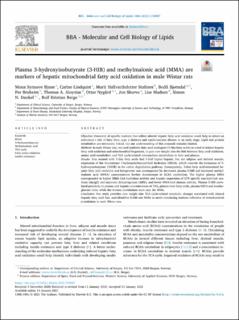| dc.contributor.author | Bjune, Mona Synnøve | |
| dc.contributor.author | Lindquist, Carine | |
| dc.contributor.author | Stafsnes, Marit Hallvardsdotter | |
| dc.contributor.author | Bjørndal, Bodil | |
| dc.contributor.author | Bruheim, Per | |
| dc.contributor.author | Aloysius, Thomas Aquinas | |
| dc.contributor.author | Nygård, Ottar | |
| dc.contributor.author | Skorve, Jon | |
| dc.contributor.author | Madsen, Lise | |
| dc.contributor.author | Dankel, Simon N | |
| dc.contributor.author | Berge, Rolf Kristian | |
| dc.date.accessioned | 2021-05-26T13:10:45Z | |
| dc.date.available | 2021-05-26T13:10:45Z | |
| dc.date.created | 2021-01-18T12:33:10Z | |
| dc.date.issued | 2021 | |
| dc.identifier.issn | 1388-1981 | |
| dc.identifier.uri | https://hdl.handle.net/11250/2756475 | |
| dc.description.abstract | Objective: Discovery of specific markers that reflect altered hepatic fatty acid oxidation could help to detect an individual's risk of fatty liver, type 2 diabetes and cardiovascular disease at an early stage. Lipid and protein metabolism are intimately linked, but our understanding of this crosstalk remains limited.
Methods: In male Wistar rats, we used synthetic fatty acid analogues (3-thia fatty acids) as a tool to induce hepatic fatty acid oxidation and mitochondrial biogenesis, to gain new insight into the link between fatty acid oxidation, amino acid metabolism and TCA cycle-related intermediate metabolites in liver and plasma.
Results: Rats treated with 3-thia fatty acids had 3-fold higher hepatic, but not adipose and skeletal muscle, expression of the thioesterase 3-hydroxyisobutyryl-CoA hydrolase (Hibch), which controls the formation of 3-hydroxyisobutyrate (3-HIB) in the valine degradation pathway. Consequently, 3-thia fatty acid-stimulated hepatic fatty acid oxidation and ketogenesis was accompanied by decreased plasma 3-HIB and increased methylmalonic acid (MMA) concentrations further downstream in BCAA catabolism. The higher plasma MMA corresponded to higher MMA-CoA hydrolase activity and hepatic expression of GTP-specific succinyl-CoA synthase (Suclg2) and succinate dehydrogenase (Sdhb), and lower MMA-CoA mutase activity. Plasma 3-HIB correlated positively to plasma and hepatic concentrations of TAG, plasma total fatty acids, plasma NEFA and insulin/glucose ratio, while the reverse correlations were seen for MMA.
Conclusion: Our study provides new insight into TCA cycle-related metabolic changes associated with altered hepatic fatty acid flux, and identifies 3-HIB and MMA as novel circulating markers reflective of mitochondrial β-oxidation in male Wistar rats. | en_US |
| dc.language.iso | eng | en_US |
| dc.publisher | Elsevier | en_US |
| dc.rights | Navngivelse 4.0 Internasjonal | * |
| dc.rights.uri | http://creativecommons.org/licenses/by/4.0/deed.no | * |
| dc.title | Plasma 3-hydroxyisobutyrate (3-HIB) and methylmalonic acid (MMA) are markers of hepatic mitochondrial fatty acid oxidation in male Wistar rats | en_US |
| dc.type | Journal article | en_US |
| dc.type | Peer reviewed | en_US |
| dc.description.version | publishedVersion | en_US |
| dc.rights.holder | Copyright 2021 The Authors | en_US |
| dc.source.articlenumber | 158887 | en_US |
| cristin.ispublished | true | |
| cristin.fulltext | original | |
| cristin.qualitycode | 1 | |
| dc.identifier.doi | 10.1016/j.bbalip.2021.158887 | |
| dc.identifier.cristin | 1873171 | |
| dc.source.journal | Biochimica et Biophysica Acta - Molecular and Cell Biology of Lipids | en_US |
| dc.identifier.citation | Biochimica et Biophysica Acta - Molecular and Cell Biology of Lipids. 2021, 1866(4), 158887 | en_US |
| dc.source.volume | 1866 | en_US |
| dc.source.issue | 4 | en_US |

